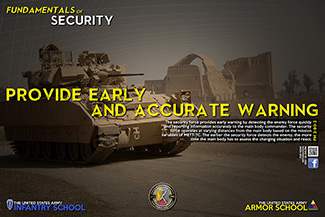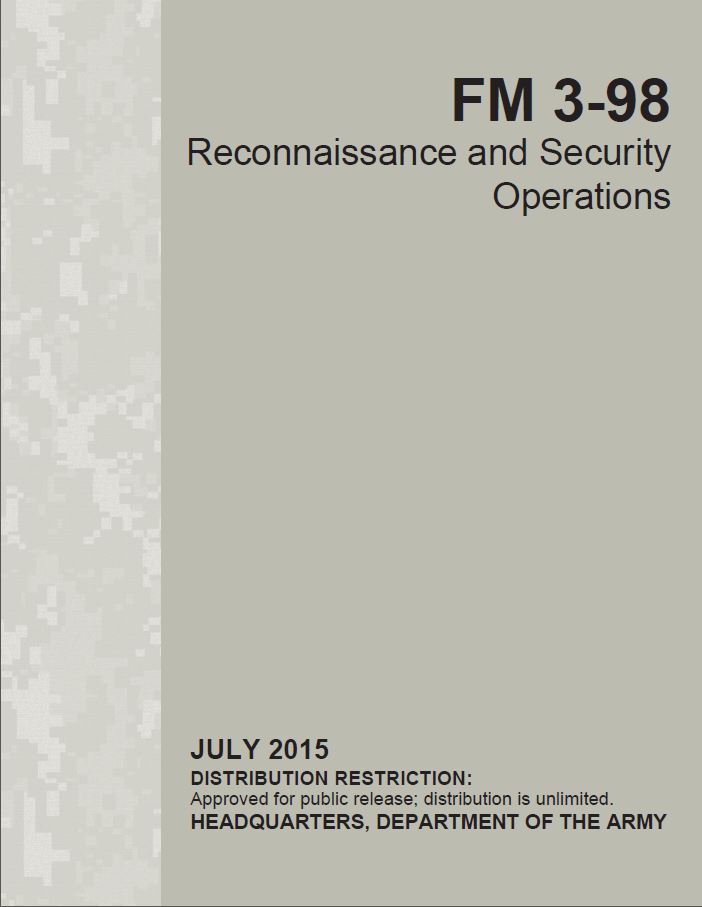PROVIDE EARLY AND ACCURATE WARNING
The security force provides early warning by detecting the enemy force quickly and reporting information accurately to the main body commander. The security force operates at varying distances from the main body based on the mission variables of METT-TC. As a minimum, it should operate far enough from the main body to prevent enemy ground forces from observing or engaging the main body with direct fires. The earlier the security force detects the enemy, the more time the main body has to assess the changing situation and react. The commander positions ground security, aerial scouts, and unmanned aircraft systems (UASs) to provide long-range observation of expected enemy avenues of approach. The commander reinforces and integrates them with available intelligence collection systems, such as unattended ground sensors (UGS), surveillance systems, and moving target indicators to maximize warning time.
Shaping the Battlefield with Cavalry: Gettysburg, the First Day
Era: US Civil War
Gettysburg is one of the most celebrated and studied battles in American history. It marked a decisive turning point in the Civil War and resulted in a major defeat from which the Confederacy never really recovered. It is also reflects the influence of cavalry operations immediately prior to and upon the first of a three-day engagement.
In June 1863 General Robert E. Lee led his Army of Northern Virginia through the Shenandoah Valley into Maryland and Pennsylvania. He sought to move the center of fighting from Virginia into the Northern states. By month’s end his forces had spread out across central Pennsylvania, but much of his cavalry had been dispatched on independent operations under its colorful commander, General J.E.B. Stuart. The significance of this detachment lay in the absence of an effective Confederate cavalry presence precisely when battle became imminent. When Lee learned that the Union Army of the Potomac had left Virginia to intercept his army, he began to concentrate his forces in south central Pennsylvania near the town of Gettysburg.
The Union Army of the Potomac moved north in several columns, screened by its cavalry. The westernmost column benefited from the protection of BG John Buford’s cavalry division. On 29 June this formation received orders to move to Gettysburg, a well known road nexus, leaving one of its brigades to cover the passes of the Catoctin Mountains that led into the army’s line of march. Buford led his remaining two brigades and one battery of artillery into Gettysburg the following day after a brief encounter with Confederate forces. He bypassed this threat in order to reach his objective unhindered.
Aware of a Confederate concentration of forces to his west but lacking more detailed information, Buford dispatched scouts to the west and north of Gettysburg. They soon identified the general locations and lines of march for the three corps of General Lee’s army. This information was transmitted to Buford’s superior and the Union army commander. Based on his scouts’ reports, Buford deployed his division to cover the primary approaches to the town from north and west. He also undertook local force protection measures including the implementation of martial law, the arrest of a suspected spy, and the prohibition of alcohol sales to his soldiers. Buford understood his mission to entail denying the Confederates access to the heights overlooking the town long enough for them to be occupied by the Army of the Potomac, arriving from the south.
Having pinpointed Confederate forces and identified their lines of march and probable objective (Gettysburg), Buford undertook preparations to delay their advance as long as possible. He prepared his two brigades to cover a seven mile arc outside the town, stretching from the west to the northeast. His main effort focused on the Chambersburg Pike that reached Gettysburg from the west, where the closest Confederate forces were encamped. A series of ridgelines crossed the road, and Buford used these to add depth to his position. His main position lay upon McPherson Ridge, where he deployed much of one brigade, supported by his artillery battery. A series of picket lines and small 4-5 man patrols occupied the ridgelines forward of this position to a depth of nearly two miles. At their most advanced point along Whistler’s Ridge, Buford’s pickets lay only a half mile from their Confederate counterparts. In Gettysburg’s Lutheran Seminary, whose high cupola permitted observation of the town and its surroundings, Buford established his signals officer.
Buford’s preparations lay in complete contrast to those undertaken by the Confederates. When a North Carolina brigade approached Gettysburg in search of shoes and discovered the Union cavalry in the town, its commander withdrew and reported the contact to his division and corps commanders. Neither officer considered the enemy presence in Gettysburg to be significant and determined to evict it the following day. They lacked detailed information of Buford’s force, and they were under orders not to trigger a general engagement before the arrival of the rest of General Lee’s army. A thorough reconnaissance of Gettysburg might have provided a more realistic assessment of the Union position, but the assets to do so were unavailable. With much of the cavalry on detached service, it was not available to locate and track the movements of the Army of the Potomac, much less conduct a deliberate reconnaissance of Gettysburg for a subordinate commander.
In the early hours of 1 July, MG Henry Heth led elements of his division down the Chambersburg Pike toward Gettysburg. They quickly encountered Buford’s forward picket line. Large numbers of Confederate skirmishers deployed to engage the pickets, while an artillery battery provided fire support. Buford’s pickets withdrew slowly, keeping the enemy engaged and unable to make a rapid advance. The Confederate advance slowed still further when Buford reinforced his forward lines. This action in turn triggered Heth to begin deploying his brigades in preparation for a general assault and commence an artillery bombardment of the Union positions. This deployment took time that Buford used to fall back upon his main line of resistance along McPherson Ridge. He also continued to send situation reports to his superiors.
By 1000 Heth’s preparations and artillery bombardment ended and his brigades began to attack Buford’s position. The Union cavalry benefited from the firepower of their carbines, but suffered from the need to assign one in four soldiers to the rear as horse handlers. Reports of Confederate forces approaching Gettysburg from the north made it impossible for Buford to shift forces from his right flank to his hard pressed defensive stand on McPherson Ridge. However, the delaying actions of the Union Cavalry denied the Confederates access to Gettysburg long enough for the infantry columns of the Army of the Potomac to arrive. As the pressure of Heth’s Confederates intensified, arriving Union infantry counterattacked and fought them to a standstill. As more US formations arrived on the field, Buford’s division moved into a reserve status, but his morning actions ensured that the Army of the Potomac secured the high ground. Over the next two days, General Lee’s army would shatter itself in repeated attacks upon these heights. The battle of Gettysburg very much reflected the shaping influence of Buford’s cavalry division.
Fundamentals Depicted (Reconnaissance):
- Ensure continuous reconnaissance
- Buford relied upon the continuous actions of scouts to pinpoint and track Confederate movements.
- MG Heth lacked an effective reconnaissance capability. His understanding of the US presence in Gettysburg was shaped by the report of a subordinate commander, whose information became outdated as soon as he withdrew from the town’s vicinity.
- Do not keep reconnaissance assets in reserve
- Buford employed his entire command to ensure that he could at minimum provide a screen that covered all likely avenues upon which Confederate forces might approach Gettysburg.
- In the days preceding the battle of Gettysburg Confederate cavalry exerted a minimal influence upon the course of events. Its most effective components led by General Stuart conducted independent operations, while those cavalry assets remaining to General Lee were not employed effectively as reconnaissance assets.
- Orient on the reconnaissance objective
- En route to Gettysburg, Buford remained cognizant of hostile troop movements in the area without becoming distracted from actually reaching the town.
- Report information rapidly and accurately
- Buford maintained a continuous flow of reports to his chain of command and the Union army commander
- Retain freedom of maneuver
- En route to Gettysburg, Buford’s division encountered Confederate pickets. Rather than seek to force a passage and risk becoming pinned in a firefight, Buford instead chose another route free of hostile forces to reach Gettysburg.
- Gain and maintain enemy contact
- Once Buford’s scouts located Confederate positions they continued to report on their actions, permitting Buford to tailor his delaying action to meet the most dangerous threat (Heth)
Fundamentals Depicted (Security):
- Provide early and accurate warning
- When Buford arrived in Gettysburg, he dispatched scouts to reconnoiter the roads leading into the town, resulting in the discovery of the main Confederate formations and their lines of advance. This information was immediately relayed to Buford’s chain of command and the Union army commander.
- The absence of Confederate cavalry ensured that Heth’s advance to Gettysburg occurred with little sense of enemy dispositions. Hence, Heth became ensnared in Union picket and patrol lines that conducted a fighting withdrawal and slowed Heth’s advance to a crawl. Heth sought to overcome this obstruction through a deliberate attack, but incurred a further time loss while deploying his division.
- Provide reaction time and maneuver space
- Buford’s deployment and delaying tactics blocked Confederate access to Gettysburg while gaining time for reinforcing Union columns to arrive on the battlefield
- Orient on the force or facility to be secured
- Upon arriving in Gettysburg Buford established blocking positions, patrols, and pickets in the direction of likely avenues of Confederate advance
- Buford’s positions were placed far enough forward to provide the best opportunity for arriving Union to secure the critical heights east and south of Gettysburg
- Perform continuous reconnaissance
- Once Buford arrived in Gettysburg he took steps to locate the enemy and track their movements. These actions continued MG Heth began to attack Buford’s forward positions
- Maintain enemy contact
- Buford maintained contact with Confederate forces until finally relieved by other Union forces arriving on the battlefield


